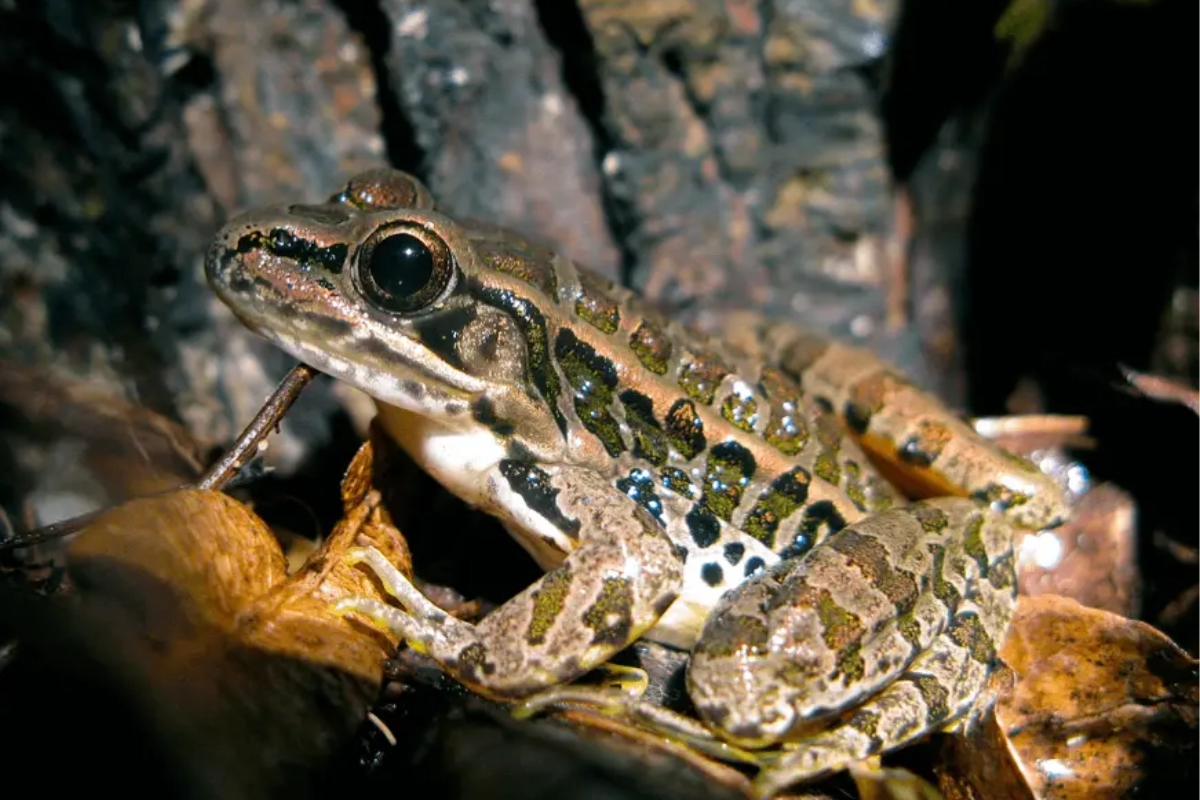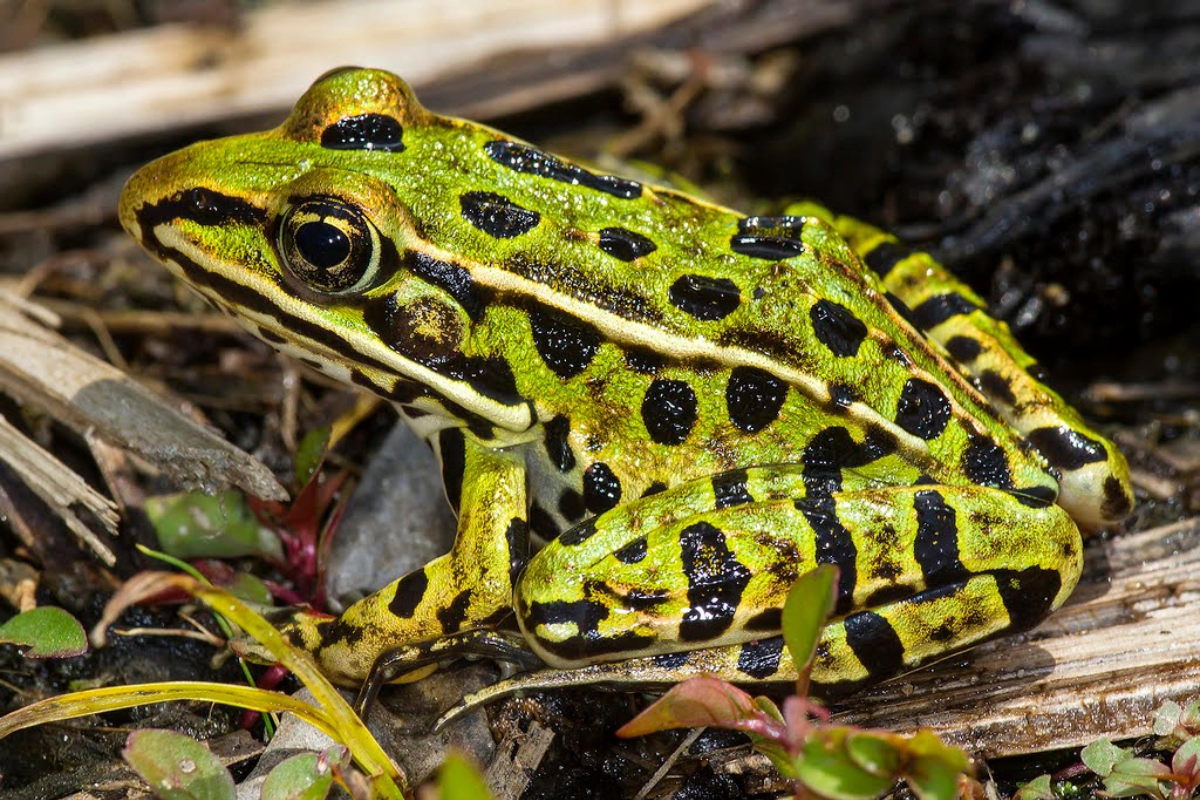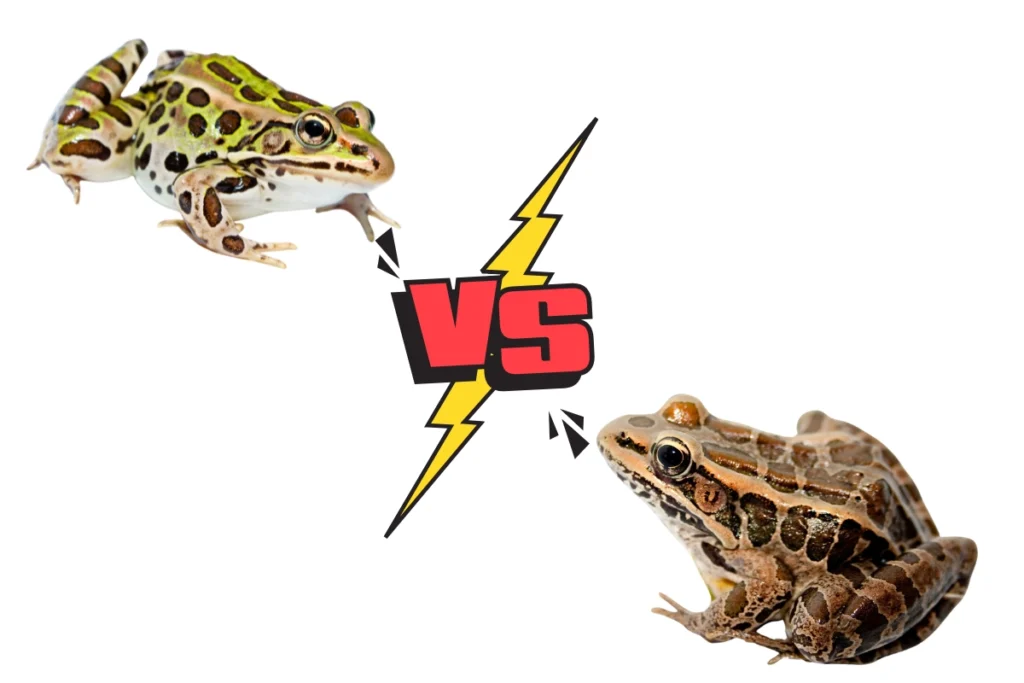Choosing between the pickerel frog vs leopard frog as a pet can be a tough decision, especially for new frog enthusiasts. Each has unique traits that might appeal to different owners, but which one suits you best? In this guide, we’ll explore the key differences and highlight which frog generally makes the best companion, helping you make an informed choice for your next pet.
Pickerel Frog
The pickerel frog, a popular choice among frog enthusiasts, is known for its distinct brown spots and unique yellow or orange coloring along its inner thighs. This frog species is a North American native, thriving in diverse environments like woodlands and wetlands. Pickerel frogs stand out in the pet world for their hardy nature and distinctive appearance.

- Technical Specifications:
- Size: 2-3 inches
- Lifespan: Up to 8 years
- Ideal Temperature: 60-75°F
- Humidity: 70-80%
- Pros:
- Hardy and adaptable to various habitats
- Distinctive coloring with vibrant yellow or orange thighs
- Low maintenance, suitable for beginners
- Generally docile, making handling easier
- Cons:
- Produces mild skin toxins that may irritate other amphibians
- Requires a specific temperature range for optimal health
Leopard Frog
The leopard frog, another North American native, is known for its vibrant green and brown patterned spots, making it visually striking. With a playful demeanor and ease of care, the leopard frog appeals to many first-time frog owners looking for a low-maintenance pet.

- Technical Specifications:
- Size: 2-5 inches
- Lifespan: Up to 6 years
- Ideal Temperature: 70-75°F
- Humidity: 70-80%
- Pros:
- Vibrant coloring and unique spotted pattern
- Active and entertaining behavior
- Low-maintenance dietary needs
- Generally friendly and adaptable to handling
- Cons:
- May need more space due to active nature
- Shorter lifespan compared to other frog species
Appearance and Coloration
The appearance of a frog can significantly impact a pet owner’s choice, especially if visual appeal is a primary factor. Both the pickerel frog and the leopard frog have unique coloring and patterns, making them attractive for different reasons.
- Pickerel Frog: Known for its muted brown background color, the pickerel frog stands out with two rows of squarish brown spots running down its back, a feature not seen in many other frog species. Its most striking characteristic, however, is the bright yellow or orange hue found along the inner thighs and underbelly. This coloration is a natural defense mechanism that deters predators, giving the pickerel frog an exotic and slightly wild look. For those who appreciate earthy tones with a splash of vibrant contrast, the pickerel frog is visually unique.
- Leopard Frog: In contrast, the leopard frog is immediately noticeable for its vibrant green or brown background, covered with darker, round leopard-like spots across its body. This bold pattern is more pronounced and colorful, often drawing attention with its brightness and classic frog appearance. The spots are distinct, with lighter borders that highlight the pattern even more. For pet owners who want a more traditionally colorful and eye-catching pet, the leopard frog’s bright, patterned look is a clear advantage.
Winner: Leopard Frog
Due to its striking green and brown coloration and classic “leopard” pattern, the leopard frog is often the preferred choice for those seeking a visually appealing and vibrant pet frog. While the pickerel frog has its unique beauty, the leopard frog’s bold colors make it stand out more in a home setting.
Size and Growth Potential
Size is an essential consideration when choosing a pet frog, as it affects both enclosure requirements and ease of handling. The pickerel and leopard frogs differ slightly in size, which may influence their suitability based on the pet owner’s preferences and space availability.
- Pickerel Frog: Generally reaching between 2 to 3 inches in length, the pickerel frog is considered a moderate-sized frog. This smaller size makes it relatively easy to house in a compact enclosure, which may appeal to those with limited space. Its modest size also makes it easier to handle and care for, especially for beginners.
- Leopard Frog: The leopard frog tends to grow slightly larger, typically between 2 to 5 inches. This larger size can make it more noticeable within its habitat, adding to its visual appeal as a display pet. However, its size also means that it may require a larger enclosure to move comfortably, especially since the leopard frog is more active. The larger size can also appeal to those who prefer a more substantial pet, though it may be a bit more challenging for smaller hands to handle carefully.
Winner: Leopard Frog
The leopard frog’s slightly larger size and more substantial presence give it an advantage for owners seeking a pet that stands out more in their enclosure. However, for those prioritizing compact spaces or smaller habitats, the pickerel frog may still be a good choice.
Temperament and Handling
The temperament of a pet frog can greatly affect the interaction between the pet and its owner. Both the pickerel frog and the leopard frog have distinct behaviors that influence how easy they are to handle and care for.
- Pickerel Frog: The pickerel frog is known for its relatively calm demeanor. It tends to be less active compared to the leopard frog, making it a suitable choice for owners who prefer a pet that isn’t overly energetic. This calmness translates to an easier handling experience, as pickerel frogs are less likely to jump or become stressed. However, they still require gentle handling to avoid undue stress.
- Leopard Frog: The leopard frog, on the other hand, is far more active and playful. Known for its energy, this frog enjoys hopping around its enclosure and exploring its surroundings. While this behavior can be entertaining for owners who enjoy watching their pet’s activities, it can make handling slightly more challenging. The leopard frog’s more energetic nature requires careful handling, as its sensitive skin can be harmed if it jumps out of an owner’s hand. However, for those who prefer observing rather than handling their pet, the leopard frog’s liveliness can be a delightful trait.
Winner: Pickerel Frog
The pickerel frog’s calm and manageable temperament makes it a better choice for owners who prioritize easy handling and a more relaxed pet experience. While the leopard frog is playful and entertaining, its energetic nature may be better suited for owners who enjoy observing rather than handling their pet frequently.
Care Requirements (Temperature and Humidity)
Providing the right environmental conditions is crucial for the health of pet frogs. Both the pickerel frog and leopard frog have specific temperature and humidity needs that can affect their suitability as pets.
- Pickerel Frog: The pickerel frog prefers a cooler environment, with an ideal temperature range of 60-75°F. This cooler requirement can make it easier to maintain in climates or homes that naturally stay within these lower temperatures. Humidity levels of 70-80% are necessary to keep the pickerel frog comfortable, so regular misting and humidity monitoring are essential.
- Leopard Frog: The leopard frog prefers a slightly warmer environment, with an ideal temperature range of 70-75°F. This makes it more adaptable to average indoor temperatures, especially in households that are naturally warmer. Like the pickerel frog, it also requires a humidity range of 70-80%, which means a similar level of upkeep in terms of misting and enclosure humidity control.
Winner: Leopard Frog
Due to its compatibility with a broader indoor temperature range, the leopard frog has a slight advantage for pet owners who may not want to invest in additional cooling equipment. Its adaptability to average room temperatures makes it a more convenient choice for those in warmer environments. However, the pickerel frog’s preference for cooler conditions might be a benefit in colder climates or for owners who already maintain lower indoor temperatures.
Diet and Feeding Habits
Both frogs are insectivores, but their dietary preferences and feeding habits can vary slightly due to their size and natural behaviors. These differences may affect the feeding routines and the types of food provided by pet owners.
- Pickerel Frog: Pickerel frogs primarily feed on small insects like crickets, flies, and worms. Due to their smaller size, they tend to consume smaller portions, making them easier to feed for owners who may not want to handle larger prey insects. Their feeding habits are straightforward, and they are generally easy to please with a regular diet of small insects.
- Leopard Frog: Being slightly larger, leopard frogs can eat a wider variety of insects and may occasionally consume larger prey, such as small roaches or larger crickets. This variety allows owners to offer a more diverse diet, which can be beneficial for the frog’s health and engagement. Leopard frogs are also quite active feeders, making feeding time a more lively experience. However, their larger appetite may require a slightly higher food budget and effort to maintain a well-rounded diet.
Winner: Leopard Frog
The leopard frog’s ability to consume a wider variety of insects and engage in active feeding makes it an appealing choice for owners who enjoy a more interactive feeding experience. However, for those seeking a low-maintenance diet, the pickerel frog’s smaller, simpler dietary needs may be an advantage.
Health and Lifespan
The lifespan and general health resilience of a frog are essential considerations, especially for pet owners who want a long-term companion. While both the pickerel frog and leopard frog are relatively hardy, their lifespans and health requirements differ slightly.
- Pickerel Frog: With proper care, the pickerel frog can live up to 8 years, offering a relatively long lifespan for a pet frog. Its robust nature and tolerance for moderate fluctuations in environment make it generally resilient to common health issues, as long as it’s provided with appropriate humidity and temperature. However, pickerel frogs can be susceptible to skin issues if their environment is not kept clean and properly humidified.
- Leopard Frog: Leopard frogs typically have a slightly shorter lifespan, averaging around 6 years. While they are generally healthy with proper care, their more active lifestyle may make them more prone to injuries, especially if they aren’t handled carefully. Additionally, leopard frogs require consistent humidity and temperature to avoid common ailments, such as respiratory infections, which can develop if they’re exposed to low humidity or sudden temperature drops.
Winner: Pickerel Frog
The pickerel frog’s longer lifespan and its slightly hardier constitution give it the edge for pet owners seeking a long-term pet that’s less prone to health issues. While the leopard frog is healthy and lively, its shorter lifespan and susceptibility to environmental changes may make it slightly less resilient in comparison.
Environmental Impact
When choosing a pet frog, it’s essential to consider its compatibility with other animals, especially if it will share a habitat, and any potential hazards it may present to other pets or humans. The pickerel and leopard frogs differ in their impact on shared environments and toxicity levels.
- Pickerel Frog: The pickerel frog produces mild skin toxins as a natural defense mechanism, which can irritate other amphibians and potentially harm small pets if they come into contact. This toxin is generally harmless to humans but requires caution, especially if the frog is handled frequently. These toxins can limit its compatibility with other amphibians, making it better suited as a solitary pet.
- Leopard Frog: Unlike the pickerel frog, the leopard frog does not produce toxins, making it a safer choice in multi-species setups. Its non-toxic nature makes it safer for children or those who may frequently handle the frog. Additionally, its generally friendly disposition allows it to be housed in compatible multi-species enclosures, provided it has sufficient space and a proper environment.
Winner: Leopard Frog
The leopard frog’s non-toxic nature and compatibility with other species make it the preferred choice for owners who may want to keep multiple amphibians or have other small pets. Its lack of toxins also makes it a safer option for frequent handling and family environments, especially for households with young children or other pets. While the pickerel frog’s toxicity is mild, its effects on other amphibians make it better suited for single-species setups.

Pickerel Frog vs. Leopard Frog: Unique Features Comparison
Pickerel Frog’s Skin Toxin Defense
- Natural Protection: The pickerel frog produces mild toxins on its skin, which deter potential predators in the wild. This unique defense mechanism can make it less susceptible to certain threats in multi-pet setups (though it requires careful management to prevent harm to other amphibians).
- Handling Caution: While harmless to humans in small amounts, this toxin requires careful handling, adding an extra layer of uniqueness for pet owners intrigued by this natural defense feature.
Pickerel Frog’s Cooler Temperature Tolerance
- Adaptable to Cooler Climates: The pickerel frog thrives in slightly lower temperatures (60-75°F) compared to many other frog species. This adaptability makes it a practical choice for pet owners in cooler environments or for those without the resources for consistent heating.
Leopard Frog’s Non-Toxic Nature
- Safety in Multi-Species Enclosures: Unlike the pickerel frog, the leopard frog does not produce any toxins, making it a safer choice for owners interested in housing multiple species together or for households with other small pets.
- Family-Friendly Pet: The lack of toxins makes the leopard frog a safer option for families with children or for frequent handling, reducing any risks associated with potential skin irritation from toxins.
Leopard Frog’s Lively and Active Behavior
- Interactive Feeding and Observational Experience: The leopard frog’s energetic nature provides an engaging experience for pet owners, especially during feeding time. This liveliness makes it an ideal choice for owners who enjoy an interactive and visually entertaining pet.
- Versatile Diet Options: Due to its larger size and active metabolism, the leopard frog can consume a wider variety of prey, allowing for a more diverse diet and feeding routine that can enrich the pet-keeping experience.
These unique features make each frog distinct, giving potential owners clear advantages depending on their individual preferences—whether they’re looking for an easy-going pet with low temperature needs or a lively, interactive frog ideal for multi-species enclosures.
Conclusion
If You Choose the Pickerel Frog:
- Ideal if you prefer a calm, easy-to-handle frog with lower activity levels.
- Best suited for cooler environments, eliminating the need for consistent heating.
- Perfect for solo enclosures where its mild toxins won’t impact other amphibians.
- Call to Action: Consider the pickerel frog if you value simplicity and a low-maintenance setup.
If You Choose the Leopard Frog:
- Great for owners who want an active, engaging pet with lively feeding habits.
- A safer choice for multi-species enclosures or families with children due to its non-toxic nature.
- Suited for those who prefer a vibrant, interactive pet experience with a more varied diet.
- Call to Action: Choose the leopard frog if you’re looking for a dynamic and family-friendly pet!
FAQ
Is the pickerel frog toxic?
Yes, the pickerel frog produces mild skin toxins that can irritate other amphibians and small animals. While generally harmless to humans, it’s advisable to wash hands after handling.
Are leopard frogs poisonous?
No, leopard frogs are not poisonous. They are safe to handle and do not produce toxins, making them suitable for multi-species environments and family settings.
What do pickerel frogs eat?
Pickerel frogs are insectivores and primarily eat small insects like crickets, flies, and worms. They are easy to feed and require a simple diet of small invertebrates.
What do leopard frogs eat?
Leopard frogs have a varied diet that includes crickets, worms, and sometimes larger insects like roaches. Their larger size allows for a broader diet, adding to the feeding experience.
How long do pickerel frogs live?
With proper care, pickerel frogs can live up to 8 years, making them a relatively long-term pet choice for frog enthusiasts.
How long do leopard frogs live?
Leopard frogs have a slightly shorter lifespan, generally living up to 6 years. Proper care and a balanced diet can help them reach their full lifespan potential.

